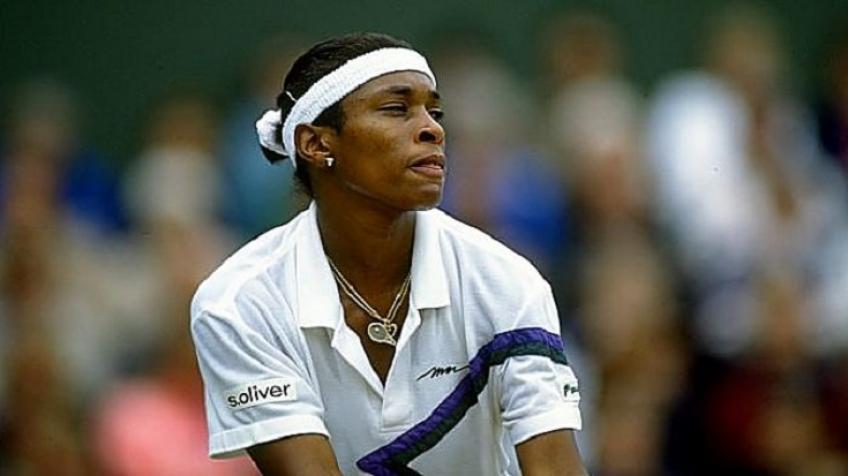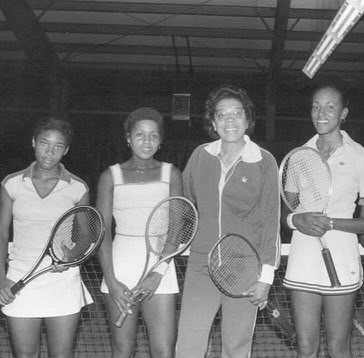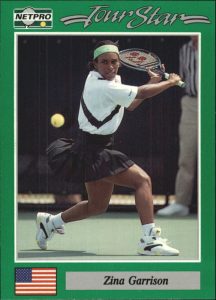In 2022, I’m counting down the 128 best players of the last century. With luck, we’ll get to #1 in December. Enjoy!
* * *
Zina Garrison [USA]Born: 16 November 1963
Career: 1981-96
Plays: Right-handed (one-handed backhand)
Peak rank: 4 (1989)
Peak Elo rating: 2,160 (5th place, 1985 and 1990)
Major singles titles: 0
Total singles titles: 14
* * *
Stories tend to lose their nuance over time, and sports history is no exception. One sportsmanlike act slowly morphs into a narrative that a player was one of the kindest ever to walk the earth. A few ill-judged remarks from a young player affect their reputation for years to come.
This tendency is reliable enough that if you come across a cartoonish, extreme description of a person or event, it’s usually safe to assume that the truth isn’t quite so one-sided. That great sportman had his warts; the outspoken youngster was selectively quoted.
Sometimes, though, the germ of the story that has survived over the decades isn’t extreme enough. So it is with the case of Zina Garrison, the grand slam finalist without a clothing sponsor.
You’ve probably heard about this. Zina spent most of the late 80s and early 90s in the top ten. She was seeded fifth at Wimbledon in 1990, in line with her WTA ranking at the time. She had the greatest fortnight of her career, racing through the first four rounds, then knocking out Monica Seles and Steffi Graf in succession to reach her sole major singles final.
Through those six matches–and for years prior to her standout run–she had no clothing sponsor. The most prominent companies didn’t believe that Black women constituted a big enough market to justify signing up a top-five player, and they didn’t have the imagination to consider that Garrison might appeal to fans outside of her own race. Only after Zina beat Graf did Reebok make her an offer commensurate with her new status as a grand slam finalist.
It’s bad enough that a perennial top-tenner didn’t have a clothing deal in large part because of her race. It gets worse.
It isn’t that no company wanted to associate themselves with Garrison. Early in 1990, her agent told the Washington Post that she had turned down offers that didn’t suit for various reasons. And for three years in the mid-80s, Zina had represented the Pony brand, a deal worth $125,000 per season. When that contract expired, she was 23 years old, continuing to perform at a high level, still showing signs that she might climb even higher.
Pony didn’t renew the deal. The company cited tight budgets while they signed blonde, blue-eyed Anne White. White was best known for wearing a lycra bodysuit at Wimbledon. Her ranking peaked at #19, and she never reached the quarter-finals of a major. Pony’s new “Golden Girl” concept had little to do with on-court achievement, and apparently it had no room for a diminutive Black woman, no matter how talented.
* * *
If we adjusted the career achievements of all-time greats by the difficulty of the obstacles they overcame, Garrison would rocket several dozen places up this list. Her years without a clothing sponsor are just one example of the systemic racism that still permeated tennis. Zina never grew taller than five-foot-five, and she struggled with bulimia for much of her career. Her height meant she had to execute her strokes that much more perfectly to succeed, and the eating disorder often robbed her of the energy needed to see out a tough match.
If it hadn’t been for the early intervention of a Houston-area coach named John Wilkerson, Garrison probably wouldn’t have become a tennis player at all. Wilkerson was a former player who set up a public-parks program, and he heard about Zina from her older brother, a baseball player at nearby Texas Southern. Around the same time, Wilkerson was introduced to Lori McNeil, another young talent just a month younger than Garrison.
Wilkerson said, “It was as if God handed these two young girls to me. They were meant to play tennis.” The coach trained all of his charges as serve-and-volleyers, and both women would rely on the strategy for their entire careers. At her best, McNeil was every bit as dangerous as Zina. She also cracked the top ten, and she twice upset Steffi Graf.
Garrison bloomed within what McNeil called Wilkerson’s “highly disciplined program.” When she was 14, Zina won the junior division of the American Tennis Association (ATA) Championships, the annual event of the leading organization of Black tennis. She and McNeil dominated ATA tournaments until they moved on to the main tour.
Wilkerson didn’t just teach technical nuts and bolts. McNeil said, “He emphasized the mental side of the game. You had to be able to think your way through a match and be mentally tough and know how to handle difficult situations.” Tough situations were plenty common for Black players in Texas. At one junior tournament, Zina overheard a tournament organizer say, “Throw the n—–s in the same bracket.”
Zina and Lori McNeil (front L and R) with the
1988 Wightman Cup-winning US team
Garrison became a WTA tour regular in 1982, and she quickly proved she belonged. In February at her hometown event in Houston, she pushed Pam Shriver to three sets. Within seven months, she had reached the quarter-finals at Roland Garros and the fourth round at both Wimbledon and the US Open, recording wins over Evonne Goolagong at the All-England Club and former champion Mima Jaušovec in Paris.
In 1983, the 19-year-old Zina improved her won-loss record to 38-19. It was the first of eleven straight seasons in which she’d win two-thirds of her matches. She reached her first final in Indianapolis, where she lost to the Hungarian top seed, Andrea Temesvári. She would go on to reach a tour-level final for 13 consecutive years, a streak only seven women in the Open Era have bettered.
* * *
A further obstacle stopping Zina Garrison from becoming a multiple major titlist was the quality of the opposition. When she arrived on tour, Martina Navratilova and Chris Evert ran the show. Steffi Graf and Gabriela Sabatini arrived soon after. By the late 80s, a new superstar was arriving on tour seemingly every year.
By won-loss record, Zina’s best season was 1989, when she went 59-15 and won three titles. She had a rough couple of weeks on grass, losing in Eastbourne to the unheralded Etsuko Inoue and at Wimbledon to the unknown Louise Field. Aside from that pair of puzzling results and a loss in Houston to Temesvári, check out the list of players who beat her:
Gabriela Sabatini Lori McNeil Steffi Graf Chris Evert Monica Seles Martina Navratilova Steffi Graf Martina Navratilova Martina Navratilova Mary Joe Fernández Martina Navratilova Gabriela Sabatini
Garrison’s career haul of only 14 titles would seem to argue against her inclusion on the Tennis 128 list, but remember that at least one of these women–and often several of them–stood in her path at nearly every event she played for a decade or more.
The women’s field wasn’t as deep then as it is today, but the players on top were as strong as in any other era, before or since. Zina’s best position in my historical Elo rankings was fifth, even worse than her peak at number four on the WTA computer. But the women in front of her set a nearly unreachable standard. Her peak rating of 2,160 is the equal of many players who ranked higher in other eras, such as Shirley Fry, Angelique Kerber, and Li Na.
Zina played 108 different women at least three times in her career, and she broke even or better with 83 of them. 37 never beat her at all. The damage was done by the handful of women who kept her stuck in the 4th or 5th spot on the ranking list. She was 2-9 against Evert, 2-12 versus Graf, 2-11 with Arantxa Sanchez Vicario, 3-10 facing Sabatini, and most painful of all, 1-33 against Navratilova.
Simply to reach her one major final, she had to beat both Seles and Graf. She was the first player–and one of only two ever–to defeat both in the same tournament. The reward for that superhuman effort was a date with Martina in the final. Zina wrote in her autobiography, “I’ll forever remember Martina as the villain of my professional career. Nearly every time we played she beat my brains out.” So it was at Wimbledon in 1990, when Garrison won only five games in the final.
* * *
It’s easy to focus on Zina’s near-misses, so let’s take a moment to review the times that she broke through. Her 14 titles include a 1985 win on clay at Amelia Island over Chris Evert, two grass-court triumphs over Pam Shriver, and a pair of final-round victories over Lori McNeil, including one in 1992 that required a 22-point deciding-set tiebreak.
She won 20 women’s doubles titles as well, including a 1988 Olympic gold medal with Shriver, three tour-level championships with McNeil, and another six with Katrina Adams. With Sherwood Stewart and Rick Leach, she won two Wimbledon mixed doubles crowns plus a third major title at the Australian Open.
Given the challenges Garrison faced, it’s remarkable that she not only ascended to the elite ranks of women’s tennis, but that she stayed there for more than a decade. In their 2007 book Charging the Net, Cecil Harris and Laryette Kyle-DeBose put her achievements in context:
[Her struggles made] her accomplishments in an anxiety-filled sport even more commendable. She split with the coach that taught her the game, and split with the best friend with whom she shared so many tennis memories, suffering silently from a negative body image and a failed marriage. Through it all, Garrison persevered. Her career serves as a reminder that it is never just a mastery of tennis strokes that makes a player what she becomes.
Zina put it a bit more succinctly: “I never allowed the fact that I was short, pigeon-toed, and black stop me from doing anything.” By the time Reebok signed her up, she had long since come to terms with the reality of the times. She learned early on to focus on what she could control, and as long as someone other than Martina was standing across the net, that meant winning an awful lot of tennis matches.


